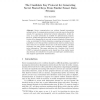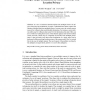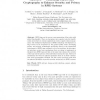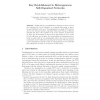ESAS
2007
Springer
14 years 7 months ago
2007
Springer
The promise of vehicular communications is to make road traffic safer and more efficient. However, besides the expected benefits, vehicular communications also introduce some priva...
ESAS
2007
Springer
14 years 7 months ago
2007
Springer
Secure communication over wireless channels necessitates authentication of communication partners to prevent man-in-the-middle attacks. For spontaneous interaction between independ...
ESAS
2007
Springer
14 years 9 months ago
2007
Springer
Responding to misbehavior in ad-hoc and sensor networks is difficult. We propose new techniques for deciding when to remove nodes in a decentralized manner. Rather than blackballin...
ESAS
2007
Springer
14 years 9 months ago
2007
Springer
The problem of secure routing in mobile ad hoc networks is long-standing and has been extensively studied by researchers. Recently, techniques of aggregating signatures have been a...
ESAS
2007
Springer
14 years 9 months ago
2007
Springer
Abstract. It is now well known that data-fusion from multiple sensors can improve detection and localisation of targets. Traditional data fusion requires the sharing of detailed da...
ESAS
2007
Springer
14 years 9 months ago
2007
Springer
Abstract. Node compromise is a serious threat in wireless sensor networks. Particular in networks which are organized in clusters, nodes acting as cluster heads for many cluster no...
ESAS
2007
Springer
14 years 9 months ago
2007
Springer
RFID-tags can be seen as a new generation of bar codes with added functionality. They are becoming very popular tools for identification of products in various applications such a...
ESAS
2007
Springer
14 years 9 months ago
2007
Springer
Traditional key pre-distribution schemes in sensor and ad hoc networks rely on the existence of a trusted third party to generate and distribute a key pool. The assumption of a sin...
ESAS
2007
Springer
14 years 9 months ago
2007
Springer
The Direct Anonymous Attestation (DAA) scheme provides a means for remotely authenticating a trusted platform whilst preserving the user’s privacy. The protocol has been adopted ...
ESAS
2007
Springer
14 years 9 months ago
2007
Springer
Location information can be used to enhance mutual entity authentication protocols in wireless ad-hoc networks. More specifically, distance bounding protocols have been introduced...






